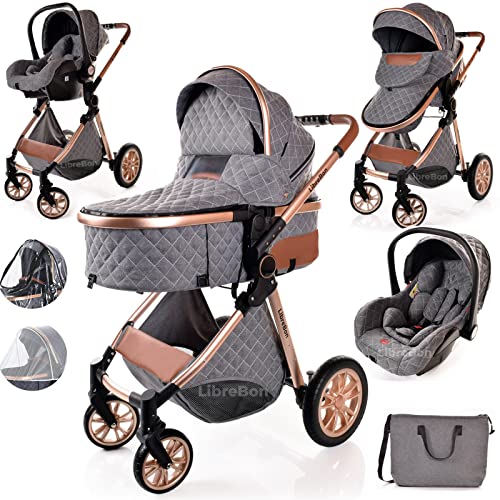Understanding Pushchairs and Prams: A Comprehensive Guide
When it pertains to baby mobility, the terms "pushchair" and "pram" are often used interchangeably. Nevertheless, they represent distinct kinds of baby carriers, each engineered for specific phases of a kid's development and varied adult requirements. This article explores the crucial differences between pushchairs and prams, their features, types, and considerations for new moms and dads.
What is a Pushchair?
A pushchair, commonly referred to as a stroller in some regions, is created for kids who can stay up independently. Usually, pushchairs are modern, light-weight, and have a seat that can be reclined for added convenience. They might also feature a five-point harness to ensure the child's safety while on the go.
Secret Features of Pushchairs
- Light-weight Design: Most pushchairs are made from lighter materials, making them easy to maneuver and transport.
- Adjustable Seats: Many models use recline options, accommodating resting or active positions.
- Canopy: Most pushchairs come geared up with a sunshade or canopy to secure the child from sun exposure.
- Storage Space: They typically include a lower storage basket, perfect for holding diaper bags or shopping.
Typical Types of Pushchairs
- Standard Pushchairs: Traditional options suitable for children who can sit separately.
- Umbrella Strollers: Lightweight, compact, and simple to fold; suitable for taking a trip.
- All-Terrain Strollers: Built with bigger wheels for off-road abilities and smooth rides on diverse surfaces.
- Travel Systems: Combines a stroller and a baby vehicle seat, allowing parents to move their child effortlessly.
What is a Pram?
A pram, brief for "perambulator," is mainly designed for infants, typically from birth until roughly 6 months. Prams are structured with a flat lying position that supports a newborn's anatomy, ensuring they are nestled appropriately.
Secret Features of Prams
- Flat Bed Design: Prams have a completely flat bed, which is essential for young babies who require to lie flat for convenience and health.
- Stylish Aesthetics: Many prams boast vintage or traditional styles, typically seen with elegant materials and appealing finishes.
- Suspension System: Quality prams typically include a suspension system to supply a smoother trip over rough surface.
- Extended Canopy: Extended sun security and rain covers are typical.
Common Types of Prams
- Traditional Prams: Featuring a conventional design, these are frequently styled to stimulate fond memories.
- Convertible Prams: These can rapidly change from a pram to a pushchair and typically grow with the child.
- Light-weight Prams: More compact than standard prams, making them much easier to carry.
Distinctions Between Pushchairs and Prams
| Function | Pushchair | Pram |
|---|---|---|
| Use Case | For children who can sit up | For newborns and babies |
| Design | Upright seat with reclining choice | Flat bed for resting |
| Weight | Normally lighter | Heavier due to durable building |
| Compactness | Folds quickly and compactly | May be bulkier, depending upon design |
| Age Range | 6 months to 4 years or older | Birth to around 6 months |
| Rate Range | More affordable choices available | Often more expensive due to products and design |
Picking Between a Pushchair and Pram
When selecting between a pushchair and a pram, a number of aspects call for consideration:
- Age of the Child: Newborns require a pram; older babies and young children will be more comfy in a pushchair.
- Lifestyle Needs: Parents who travel frequently might choose lightweight pushchairs, while those trying to find convenience in style might favor prams.
- Budget: Prams can range from reasonably to high-priced; credible pushchairs can accommodate budget-conscious buyers.
- Storage Space: Consider how quickly the chosen design can fit in your vehicle trunk or home storage.
FAQs
Q1: Can I utilize a pushchair for a newborn baby?
While certain pushchairs are created with reclining features that may accommodate infants, it is generally recommended to use a pram or specifically developed infant cars and truck seat for newborns.
Q2: Are travel systems worth the investment?
Travel systems can offer convenience by integrating a car seat and a stroller. Foldable Double Pram enable seamless shift from vehicle to stroller, which numerous parents discover invaluable.
Q3: How do I preserve my pushchair or pram?
Regularly clean the fabric, check for mechanical problems, and lube the wheels. Ensure to follow particular care guidelines provided by the producer.
Q4: What is the weight limitation for pushchairs and prams?
Weight limits differ by model: usually, pushchairs accommodate as much as 50 pounds, while prams fit babies up to 30 lbs. Constantly refer to the manufacturer's guidelines.
Q5: Is it necessary to have a rain cover for my pushchair or pram?
Yes, a rain cover can protect your kid from rain and wind, preserving comfort while avoiding damp clothing.
In summary, pushchairs and prams serve crucial but distinct roles in the movement landscape for moms and dads and caretakers. Picking the best design depends upon the kid's age, lifestyle requirements, and family choices. By comprehending the qualities, advantages, and distinctions in between pushchairs and prams, parents can make educated choices that ensure comfort and security for their child. Whether walking through the park or browsing busy streets, the best movement solution is out there waiting.

